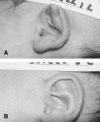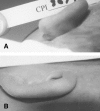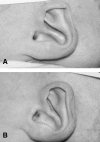Nonsurgical correction of congenital ear abnormalities in the newborn: Case series
- PMID: 19675840
- PMCID: PMC2722971
- DOI: 10.1093/pch/10.6.327
Nonsurgical correction of congenital ear abnormalities in the newborn: Case series
Abstract
Objective: To determine whether a simple, nonsurgical treatment for congenital ear abnormalities (lop-ear, Stahl's ear, protruding ear, cryptotia) improved the appearance of ear abnormalities in newborns at six weeks of age.
Methods: This is a descriptive case series. All newborns with identified abnormalities were referred by their family physician to one paediatrician (WGS) in a small level 2 perinatal centre. The ears were waxed and taped in a standard manner within 10 days of birth. Pictures were taken before taping and at the end of taping (one month). All patients and pictures were assessed by one plastic surgeon (JWT) at six weeks of age and scored using a standard scoring system. A telephone survey of the nontreatment group was conducted.
Results: The total number of ears assessed was 90. Of this total, 69 ears were taped and fully evaluated in the study (77%). The refusal rate was 23%. In the treatment group, 59% had lop-ear, 19% had Stahl's ear, 17% had protruding ear and 3% had cryptotia. Overall correction (excellent/improved) for the treatment group was 90% (100% for lop-ear, 100% for Stahl's ear, 67% for protruding ear and 0% for cryptotia). In the nontreatment (refusal) group, 67% of the ears failed to correct spontaneously. No complications were recognized by the authors or parents by six weeks. The percentage of newborns in one year in the perinatal centre with recognized ear abnormalities was 6% (90 of 1600).
Conclusions: A simple, nonsurgical treatment in a Caucasian population appeared to be very effective in correcting congenital ear abnormalities with no complications and high patient/parent satisfaction.
OBJECTIF: Déterminer si un traitement non chirurgical simple des anomalies congénitales de l’oreille (oreille en anse, oreille de Stahl, oreille décollée, cryptotie) améliore l’apparence des anomalies de l’oreille chez les nouveau-nés à six semaines.
MÉTHODOLOGIE: Il s’agit d’une série descriptive de cas. Tous les nouveau-nés ayant une anomalie diagnostiquée ont été aiguillés par leur médecin de famille vers un pédiatre (WGS) d’un petit centre périnatal de soins secondaires. Les oreilles ont été cirées et fixées à l’aide de ruban adhésif de manière standard dans les dix jours suivant la nais-sance. Des photos ont été prises avant l’installation de l’adhésif et à la fin du traitement (un mois). Tous les patients et toutes les photos ont été évalués par un plasticien (JWT) lorsque les nouveau-nés avaient six semaines et ont été classés selon un système de classement standard. Une enquête téléphonique auprès du groupe non traité a été exécutée.
RÉSULTATS: Quatre-vingt-dix oreilles ont été évaluées au total. De ce nombre, 69 oreilles ont été fixées à l’aide d’adhésif et ont fait l’objet d’une évaluation complète pendant l’étude (77 %). Le taux de refus était de 23 %. Au sein du groupe traité, 59 % avait des oreilles en anse, 19 %, des oreilles de Stahl, 17 %, des oreilles décollées et 3 %, une cryptotie. La correction globale (excellente, améliorée) du groupe de traitement était de 90 % (100 % dans le cas des oreilles en anse et des oreilles de Stahl, 67 % dans celui des oreilles décollées et 0 % dans celui de la cryptotie). Au sein du groupe non traité (ayant refusé le traitement), 67 % des oreilles ne se sont pas corrigées spon-tanément. Aucune complication n’avait été observée par les auteurs ou les parents à l’âge de six semaines. En un an, le pourcentage de nouveau-nés présentant une anomalie dépistée de l’oreille au sein du centre périnatal était de 6 % (90 sur 1 600).
CONCLUSIONS: Un traitement non chirurgical simple auprès de la population blanche semble très efficace pour corriger les anomalies congénitales de l’oreille, sans complication. Il s’associe à une satisfaction élevée des patients et des parents.
Keywords: Abnormality; Auricle; Congenital; Ear.
Figures





Similar articles
-
Nonsurgical correction of congenital auricular deformities.Clin Plast Surg. 1990 Apr;17(2):383-95. Clin Plast Surg. 1990. PMID: 2189652 Review.
-
[The treatment efficiency of a new ear moding device in the infants with congenital ear abnormalities].Lin Chuang Er Bi Yan Hou Tou Jing Wai Ke Za Zhi. 2017 Jun 5;31(11):849-853. doi: 10.13201/j.issn.1001-1781.2017.11.008. Lin Chuang Er Bi Yan Hou Tou Jing Wai Ke Za Zhi. 2017. PMID: 29775000 Chinese.
-
Neonatal molding in deformational auricolar anomalies.Eur Rev Med Pharmacol Sci. 2012 Oct;16(11):1554-8. Eur Rev Med Pharmacol Sci. 2012. PMID: 23111969
-
[Analysis of risk factors for congenital auriclar deformity and its different types].Lin Chuang Er Bi Yan Hou Tou Jing Wai Ke Za Zhi. 2024 Feb;38(2):160-163;167. doi: 10.13201/j.issn.2096-7993.2024.02.015. Lin Chuang Er Bi Yan Hou Tou Jing Wai Ke Za Zhi. 2024. PMID: 38297872 Free PMC article. Chinese.
-
Evaluation and Nonsurgical Treatment of Neonatal Ear Anomalies: A Case Report.Adv Neonatal Care. 2022 Aug 1;22(4):317-324. doi: 10.1097/ANC.0000000000000999. Epub 2022 Jul 8. Adv Neonatal Care. 2022. PMID: 35816427 Review.
Cited by
-
Topics in otoplasty: ear deformity and auricular constriction.Eplasty. 2011;11:ic12. Epub 2011 Jul 8. Eplasty. 2011. PMID: 21847435 Free PMC article. No abstract available.
-
Non-surgical Correction of Congenital Ear Anomalies: A Review of the Literature.Plast Reconstr Surg Glob Open. 2020 Nov 24;8(11):e3250. doi: 10.1097/GOX.0000000000003250. eCollection 2020 Nov. Plast Reconstr Surg Glob Open. 2020. PMID: 33299713 Free PMC article.
-
The self-correction and influence factors of congenital auricular deformity: A prospective cohort study.PLoS One. 2024 Oct 7;19(10):e0309621. doi: 10.1371/journal.pone.0309621. eCollection 2024. PLoS One. 2024. PMID: 39374202 Free PMC article.
-
Correction of Congenital Auricular Deformities Using the Ear-Molding Technique.Arch Plast Surg. 2016 Nov;43(6):512-517. doi: 10.5999/aps.2016.43.6.512. Epub 2016 Nov 18. Arch Plast Surg. 2016. PMID: 27896180 Free PMC article.
-
Non-surgical Management of Congenital Auricular Deformities.World J Plast Surg. 2016 May;5(2):139-47. World J Plast Surg. 2016. PMID: 27579269 Free PMC article.
References
-
- Matsuo K, Hirose T, Tomono T, et al. Nonsurgical correction of congenital auricular deformities in the early neonate: A preliminary report. Plast Reconstr Surg. 1984;73:38–51. - PubMed
-
- Matsuo K, Hayashi R, Kiyono M, Hirose T, Netsu Y. Nonsurgical correction of congenital auricular deformities. Clin Plast Surg. 1990;17:383–95. - PubMed
-
- Kurozumi N, Ono S, Ishida H. Non-surgical correction of a congenital lop ear deformity by splinting with Reston foam. Br J Plast Surg. 1982;35:181–2. - PubMed
-
- Furnas DW. Nonsurgical treatment of auricular deformities in neonates and infants. Pediatr Ann. 1999;28:387–90. - PubMed
-
- Brown FE, Colen LB, Addante RR, Graham JM., Jr Correction of congenital auricular deformities by splinting in the neonatal period. Pediatrics. 1986;78:406–11. - PubMed
LinkOut - more resources
Full Text Sources
Other Literature Sources
